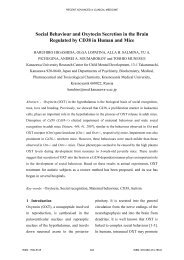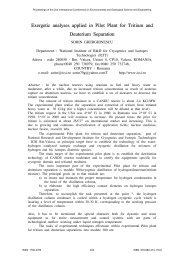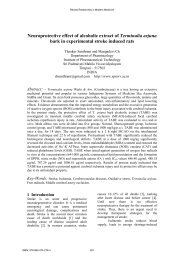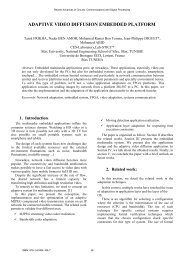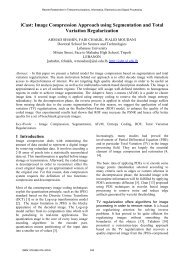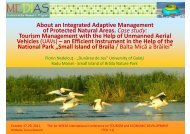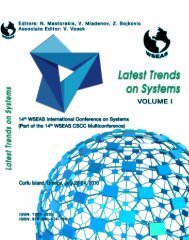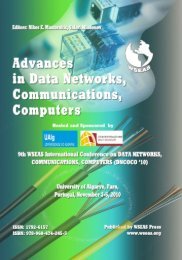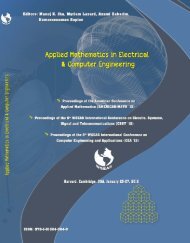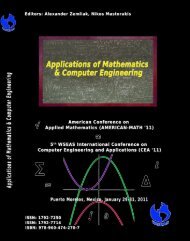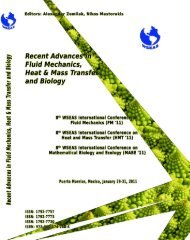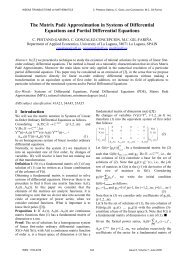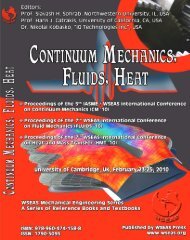MATHEMATICAL METHODS AND APPLIED COMPUTINGPlenary Lecture 8Decision Precising Technologies in Decision Making SystemsProfessor Gia SirbiladzeDepartment of Computer ScienceFaculty of Exact & Natural SciencesIv. Javakhishvili Tbilisi State UniversityGeorgiaE-mail: gia.sirbiladze@tsu.geAbstract: To ensure the effectiveness of decision-support computer systems it is essential to solve such problems asidentification, filtration, precision etc. of information streams, as well as modeling <strong>and</strong> simulation of decision-makingproblems which are based on them. When working with information streams of expert knowledge, as a complexsystems, in parallel with classical approaches of their modeling, the most important matter is to assume fuzziness. Allthese is connected to the complicity of study of incomplete, abnormal <strong>and</strong> extreme processes in nature <strong>and</strong> society,which are ca<strong>us</strong>ed by lack or shortage of objective information <strong>and</strong> when expert data streams are essential forconstructing credible decisions. Such problems include solutions of b<strong>us</strong>iness problems in extreme environments,analysis of management <strong>and</strong> investment risks, problems of conflictology, sociology, medical diagnosis, etc. With thegrowth of complexity of information our ability to make credible decision about process development reduces to somelevel, below which some characteristics such as accuracy <strong>and</strong> certainty become mutually conflicting. Our research isconcerned with quantitative-fundamental analysis of this uncertainty <strong>and</strong> its <strong>us</strong>e for precision of informationalprocesses <strong>and</strong> decision modeling. Consequently one of main objects of our attention is the analysis of structures ofexpert data <strong>and</strong> measures of its uncertainty. The most important of such analysis <strong>methods</strong> are the theory of the bodyof evidence.The precision of decisions first of all means improvement of representation of decision making factors by Dempster-Shafer data structures. Of course, there are many <strong>methods</strong> for knowledge representations <strong>and</strong> decision making,which <strong>us</strong>e the Dempster-Shafer structures. The novelty of our research in this direction is the technology for precisionof the structure of body of evidence, which we call the temporalization of body of evidence. Temporalization meansthe construction of incl<strong>us</strong>ion relation on the bodies of evidence. This approach is completely novel in study of expertknowledge representations <strong>and</strong> structuring. It will ca<strong>us</strong>e many heurstic <strong>methods</strong> of decision- making based on theexpert knowledge representation to be modified. All above listed means the following: 1. representation of data whichis an input of considered <strong>methods</strong> <strong>us</strong>ing Dempster-Shafer structures, so called pessimistic-optimistic representations.This will better exhibit the knowledge <strong>and</strong> intellectual activities of an expert. 2. the possibilities of representing ofexpert information streams in triangular or trapezioform fuzzy numbers will be considered. 3. the cases where focalelements in Dempster-Shafer structure are represented by fuzzy sets, <strong>and</strong> focal probabilities are represented bytriangular or trapezioform fuzzy numbers will be considered separately, 4. in <strong>methods</strong>’ decision-making criteriarepresented in knowledge base of decision support technologies of inaccuracy <strong>and</strong> uncertainty aggregations will be<strong>us</strong>ed such as: Choquet integral, Sugeno integral, Dempster upper <strong>and</strong> lower expected values, positive <strong>and</strong> negativediscriminations, OWA operators, etc. 5. in selected <strong>methods</strong> these aggregations will give <strong>us</strong> new criteria supportingmore precise decision. Th<strong>us</strong> existing heuristic <strong>methods</strong> will obtain fundamental basis, final purpose of which will be tomodel more precise decision in the cases of expert knowledge streams input. 6. The decision support system willobtain higher credibility, which can be measured in new modified <strong>methods</strong> <strong>us</strong>ing the informational measures, such asconf<strong>us</strong>ion <strong>and</strong> chaos constructed on more precise decisions, inaccuracy <strong>and</strong> non-specificity measures etc.Finally the process of precising decisions will be demonstrated based on Discrimination method which is one of thepopular <strong>methods</strong> of decision making <strong>us</strong>ing fuzzy set theory.Brief Biography of the Speaker:Dr. Gia Sirbiladze is a full professor at the Department of Computer Science of Faculty of Exact & Natural Sciences ofIv. Javakhishvili Tbilisi State University, Georgia. He received his Ph.D. degree in 1991 from the ComputationalMathematics Institute of the Georgian Academy of Science. He received his D. Sci. degree from the same institute in2005. His scientific interests include areas such as Intelligent Fuzzy Technologies <strong>and</strong> General Systems, FuzzyTechnologies in Decision-making Support Systems, Fuzzy Extremal Dynamic Systems - Control, Filtration <strong>and</strong>Identification, Fuzzy Discrete Optimization Problems <strong>and</strong> Modeling Decisions.ISSN: 1790-2769 27 ISBN: 978-960-474-124-3
MATHEMATICAL METHODS AND APPLIED COMPUTINGPlenary Lecture 9Iterative Numerical Methods for Simulation of Coupled Engineering ProblemsAssociate Professor Ion CarsteaUniversity Of CraiovaRomaniaE-mail: ion_crst@yahoo.comAbstract: Any electromagnetic device is the ho<strong>us</strong>e of two or more physical fields that interact by a number ofparameters as the material properties, the field sources etc. In other words we have not separate problems forengineers from different science branches although for economic reasons in terms of computer resources, eachphysical field is considered as though it was separate field <strong>and</strong> generates a problem which is solved independently.The subsystems <strong>and</strong> numerical solutions are finally coupled together in such way that interactions are satisfied withan "acceptable" degree of accuracy. This is a natural approach for the analysis of large or complex structures but theaccuracy of the analysis is not good.The technique of dividing a large physical system into a system of components is very old <strong>and</strong> is still <strong>us</strong>ed extensivelyalthough the reasons of this approach are not valid nowadays. We have an increased computing power withadvanced computer architectures so that it is an antisocial fact to ignore this real computing power.In our lecture we intend to review the state-of-the-art of iterative <strong>methods</strong> for solving large sparse systems such asarising in coupled engineering problems. The solution of practical problems of mathematical physics ultimately relieson solving a system of partial derivative equations <strong>and</strong> this is only achieved by iterative numerical <strong>methods</strong>. Iterativesolution <strong>methods</strong> proceed by adding successive corrections to some arbitrary initial approximation, but unfortunatelythese <strong>methods</strong> are very sensitive to specific features of the system to be solved. A procedure call preconditioning ispossible but is not always <strong>us</strong>ed.We limit our presentation to a large class of systems defined by elliptic-parabolic mathematical models thatrepresents the basis of the electromagnetic-thermal problems. The numerical models are obtained by the finitedifferences <strong>and</strong> finite element <strong>methods</strong>. The motivation is simple: for parabolic problems we <strong>us</strong>e an explicit schemefor temporal discretization, <strong>and</strong> for elliptic problem we <strong>us</strong>e the finite element method. As target example we <strong>us</strong>e anelectromagnetic-thermal coupled problem from electrical engineering.In the algorithmic skeletons for this class of problems we are guided by the implementation of the algorithms on theparallel computers with emphasis on parallel computers (MIMD architectures).Brief Biography of the Speaker:The speaker is an Assoc. Professor at the Computer Engineering <strong>and</strong> Communications Department, Faculty ofAutomatics, Computers <strong>and</strong> Electronics, University of Craiova, Romania.He has a BSc <strong>and</strong> MSc in Automatics from the University of Craiova, Romania. He has a Ph.D. in Automatics fromthe University of Ploiesti, Romania. Also, he has a BSc <strong>and</strong> MSc in Mathematics from the Natural Sciences Faculty,University of Craiova, Romania.He was director of the research projects supported by international grants at University of Ho<strong>us</strong>ton (USA)- 6 months(Fulbright Grant), at the University of Coimbra, Portugal – 9 months (NATO grant), at the Polytechnics of Milano,Italy- 4 months (a CNR-NATO grant). In 2004 he was invited at the Mathematics Department, University of Trento,Italy, for 2 months.Ion Carstea published 10 books in the area of programming languages advanced computers <strong>and</strong> CAD of theelectromagnetic devices. He is the co-author of the book FINITE ELEMENTS in WSEAS Press, 2007.He is the author of more than 160 papers in revues, scientific journals <strong>and</strong> international conference proceedings. Heis a reviewer for several WSEAS International Conferences <strong>and</strong> was a member in many international scientificcommittees. In the year 2007, he was a Plenary speaker <strong>and</strong> chair at the WSEAS Conferences from Arcachon(France) <strong>and</strong> Venice (Italy). In 2008 he was Plenary speaker to two WSEAS Conferences from Bucharest (June2008, November 2008).His research interests include parallel algorithms for numerical simulation of the distributed-parameter systems,software products for coupled <strong>and</strong> inverse problems in engineering, domain decomposition method in the context ofthe finite element method.ISSN: 1790-2769 28 ISBN: 978-960-474-124-3




